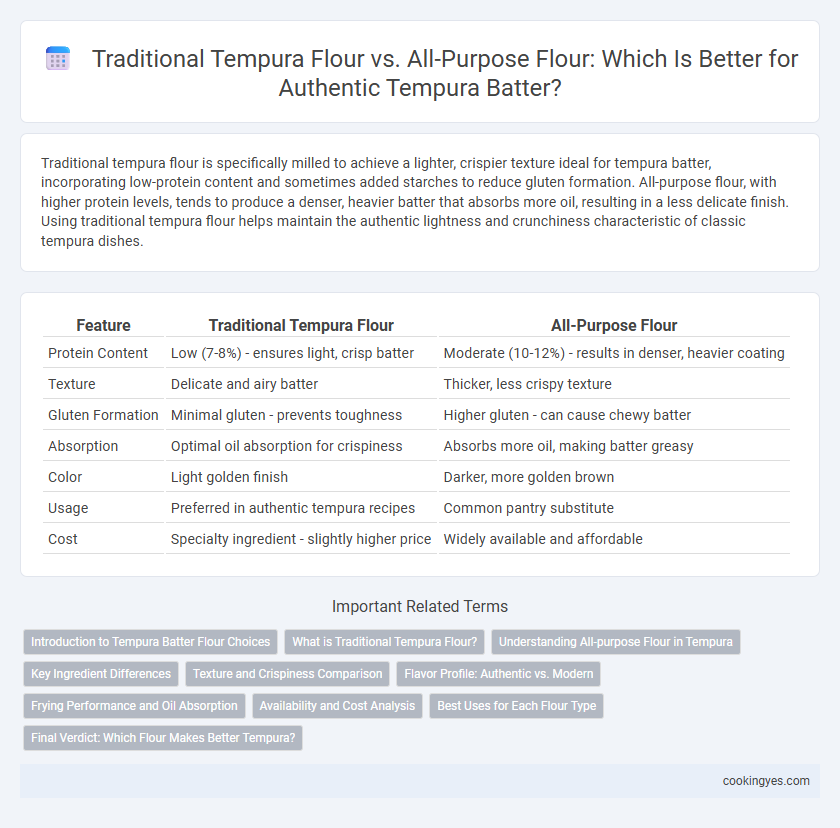Traditional tempura flour is specifically milled to achieve a lighter, crispier texture ideal for tempura batter, incorporating low-protein content and sometimes added starches to reduce gluten formation. All-purpose flour, with higher protein levels, tends to produce a denser, heavier batter that absorbs more oil, resulting in a less delicate finish. Using traditional tempura flour helps maintain the authentic lightness and crunchiness characteristic of classic tempura dishes.
Table of Comparison
| Feature | Traditional Tempura Flour | All-Purpose Flour |
|---|---|---|
| Protein Content | Low (7-8%) - ensures light, crisp batter | Moderate (10-12%) - results in denser, heavier coating |
| Texture | Delicate and airy batter | Thicker, less crispy texture |
| Gluten Formation | Minimal gluten - prevents toughness | Higher gluten - can cause chewy batter |
| Absorption | Optimal oil absorption for crispiness | Absorbs more oil, making batter greasy |
| Color | Light golden finish | Darker, more golden brown |
| Usage | Preferred in authentic tempura recipes | Common pantry substitute |
| Cost | Specialty ingredient - slightly higher price | Widely available and affordable |
Introduction to Tempura Batter Flour Choices
Traditional tempura batter flour typically consists of low-protein wheat flour, which produces a lighter, crispier texture due to reduced gluten formation. In contrast, all-purpose flour contains higher protein content, resulting in a denser, chewier coating that can mask the delicate crispiness characteristic of authentic tempura. For an optimal tempura batter, using specialized tempura flour or a mix of cake flour and cornstarch enhances lightness and crispness while maintaining structural integrity during frying.
What is Traditional Tempura Flour?
Traditional tempura flour is a specially formulated blend designed to create a light, crispy batter essential for authentic Japanese tempura, often containing a mix of low-protein wheat flour and starches such as rice or potato starch. Unlike all-purpose flour, which has a higher protein content and results in a denser, heavier batter, traditional tempura flour produces a delicate, airy texture that fries to a crisp without excess oil absorption. This unique composition enhances the batter's ability to cling evenly to seafood or vegetables while maintaining a characteristic crunch and minimal greasiness.
Understanding All-purpose Flour in Tempura
All-purpose flour, commonly used in many recipes, contains a moderate protein content that can develop gluten, resulting in a slightly denser and chewier tempura batter compared to traditional tempura flour. Traditional tempura flour often incorporates low-gluten wheat or a blend with rice starch, creating a lighter, crispier texture ideal for tempura's delicate coating. Understanding the role of all-purpose flour helps in adjusting batter consistency and achieving a tempura crust with a balance between crispness and slight chewiness.
Key Ingredient Differences
Traditional tempura flour contains a unique blend of low-protein wheat flour, rice flour, and sometimes starches, creating a light, crispy texture that all-purpose flour cannot replicate due to its higher protein content. All-purpose flour's gluten formation results in a denser and chewier batter that lacks the delicate crispiness essential for authentic tempura. The specialized tempura flour minimizes gluten development, ensuring the batter remains thin and airy, ideal for frying seafood and vegetables to perfection.
Texture and Crispiness Comparison
Traditional tempura flour contains a lower protein content than all-purpose flour, resulting in a lighter, airier batter that crisps quickly without becoming heavy or greasy. The starch profile in tempura flour absorbs less oil, producing a delicate, brittle texture that enhances the natural flavors of seafood and vegetables. In contrast, all-purpose flour's higher gluten content creates a denser, chewier coating that can compromise the hallmark crispiness sought in authentic tempura dishes.
Flavor Profile: Authentic vs. Modern
Traditional tempura flour yields a lighter, crispier batter with a subtle nutty flavor essential to authentic Japanese tempura, enhancing the freshness of seafood and vegetables. All-purpose flour produces a denser, heavier batter with a neutral taste that can mask delicate ingredients' natural flavors. Choosing traditional tempura flour ensures a more genuine, delicate flavor profile, while all-purpose flour offers a modern, versatile option with a heartier texture.
Frying Performance and Oil Absorption
Traditional tempura flour contains low-protein starches and leavening agents, resulting in a lighter, crispier batter with superior frying performance compared to all-purpose flour. It absorbs less oil due to its unique composition, producing a less greasy and more delicate texture. In contrast, all-purpose flour tends to create a denser batter that absorbs more oil, leading to a heavier, oilier tempura.
Availability and Cost Analysis
Traditional tempura flour, typically made from low-protein wheat, offers a lighter, crispier texture but is often more expensive and less widely available outside specialty Asian markets. All-purpose flour is readily available in most grocery stores and significantly more cost-effective, though it produces a denser, heavier batter that may not achieve the authentic tempura crispiness. For budget-conscious cooks seeking convenience, all-purpose flour provides an accessible alternative despite the slight compromise in traditional texture.
Best Uses for Each Flour Type
Traditional tempura flour contains a blend of low-protein wheat and rice flour, which creates a lighter, crispier batter ideal for delicate seafood and vegetables. All-purpose flour, with its higher protein content, yields a thicker, crunchier coating suitable for heartier ingredients like root vegetables and meats. Using tempura flour ensures an airy texture that enhances the natural flavors, while all-purpose flour provides a more substantial bite, making each flour type best suited for specific tempura variations.
Final Verdict: Which Flour Makes Better Tempura?
Traditional tempura flour contains a refined blend of rice flour, wheat starch, and sometimes cornstarch, producing a lighter, crispier batter with minimal gluten development, essential for authentic tempura texture. All-purpose flour, with higher protein content, tends to create a denser, chewier coating, often resulting in a heavier, less delicate finish. For superior lightness and crispiness, traditional tempura flour is the preferred choice among chefs seeking authentic Japanese tempura batter quality.
Traditional Tempura flour vs All-purpose flour for batter recipe Infographic

 cookingyes.com
cookingyes.com